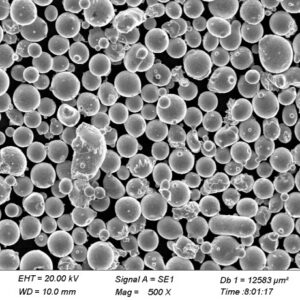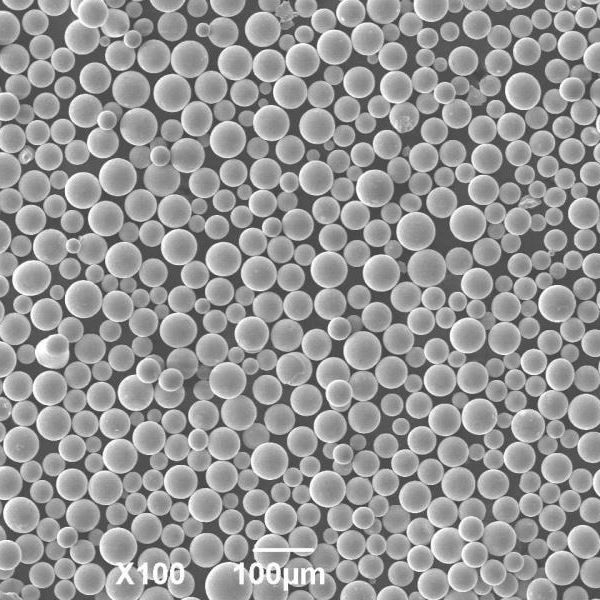Best in718 powder for 3D printing
IN718 powder is a nickel-based superalloy powder widely used in additive manufacturing processes such as powder bed fusion and direct energy deposition. It is composed primarily of nickel, with additions of chromium, iron, niobium, molybdenum, and other elements. The combination of these elements imparts exceptional mechanical strength, corrosion resistance, and high-temperature capabilities to the final printed parts.
Fast Delivery
High sphericity
High Quality
Small MOQ
Share This Product
Product Description
Properties of IN718 Powder
IN718 powder exhibits several key properties that make it highly suitable for additive manufacturing applications. These include:
- High Strength: IN718 parts possess excellent tensile and yield strength, making them suitable for demanding engineering applications.
- Corrosion Resistance: The presence of chromium in IN718 powder enhances its resistance to various corrosive environments, including acids, alkalis, and high-temperature oxidation.
- Heat Resistance: IN718 powder can withstand elevated temperatures, making it ideal for applications requiring exposure to extreme heat and thermal cycling.
- Fatigue Resistance: Parts made from IN718 powder exhibit excellent fatigue resistance, ensuring their durability and longevity.
- Weldability: IN718 powder is highly weldable, allowing for the repair and modification of printed parts as needed.
4. Applications of IN718 Powder in Additive Manufacturing
IN718 powder finds extensive applications across various industries. Some notable applications include:
- Aerospace: IN718 powder is widely used in aerospace for manufacturing turbine components, engine parts, and structural components that require high strength and heat resistance.
- Automotive: IN718 powder is utilized in the automotive industry for producing lightweight, high-performance engine parts, exhaust systems, and turbocharger components.
- Medical: IN718 powder is employed in the medical field for fabricating surgical instruments, orthopedic implants, and dental prosthetics that demand biocompatibility and high mechanical strength.
- Energy: IN718 powder is utilized in the energy sector for manufacturing gas turbine components, nuclear reactor parts, and oil and gas industry equipment.
5. Advantages of Using IN718 Powder
The utilization of IN718 powder in additive manufacturing offers several advantages, including:
- Design Flexibility: IN718 powder enables the production of complex geometries and intricate designs that are difficult or impossible to achieve using traditional manufacturing methods.
- Reduced Material Waste: Additive manufacturing with IN718 powder minimizes material waste compared to subtractive manufacturing processes, reducing costs and environmental impact.
- Rapid Prototyping: IN718 powder allows for the rapid production of prototypes, facilitating iterative design improvements and accelerating product development cycles.
- Customization: IN718 powder enables the customization of parts, catering to specific requirements and enhancing overall performance.
6. Challenges and Limitations of IN718 Powder
While IN718 powder offers numerous benefits, it also presents some challenges and limitations, including:
- Powder Quality Control: Maintaining consistent powder quality is crucial to achieving reliable and defect-free parts. Ensuring proper handling, storage, and quality control of the powder is essential.
- Processing Parameters: Optimizing process parameters, such as laser power, scanning speed, and layer thickness, is necessary to prevent issues like cracking, warping, and residual stress.
- Support Structures: Due to the high thermal gradients and shrinkage during cooling, adequate support structures must be employed to prevent part distortion and ensure dimensional accuracy.
7. Preparing IN718 Powder for Additive Manufacturing
To prepare IN718 powder for additive manufacturing, the following steps are typically involved:
- Powder Handling: The IN718 powder should be stored in a controlled environment to prevent moisture absorption and contamination. Proper powder handling techniques, such as sieving and flowability assessment, should be implemented.
- Powder Bed Preparation: The powder bed is carefully prepared by spreading a uniform layer of IN718 powder onto the build plate or substrate. The layer thickness is controlled to achieve the desired part resolution.
- Printing Process: The additive manufacturing process, such as powder bed fusion or direct energy deposition, is carried out using appropriate equipment and process parameters. The part geometry is sliced into layers, and the laser or electron beam selectively fuses the powder particles to form the desired shape.
8. Best Practices for Using IN718 Powder
To optimize the use of IN718 powder in additive manufacturing, the following best practices should be followed:
- Optimize Process Parameters: Carefully calibrate and fine-tune the process parameters to achieve the desired part quality and performance. This includes optimizing laser power, scan speed, and layer thickness.
- Implement Quality Control Measures: Establish stringent quality control measures to monitor powder quality, part integrity, and dimensional accuracy. Regular inspection and testing should be conducted to identify and rectify any issues promptly.
- Post-Processing Techniques: Employ appropriate post-processing techniques, such as heat treatment, stress relief, and surface finishing, to enhance the properties and performance of the printed parts.
9. Quality Control and Testing of IN718 Parts
Ensuring the quality and integrity of IN718 parts is crucial. Various testing and quality control techniques can be employed, including:
- Non-Destructive Testing: Techniques such as X-ray inspection, ultrasonic testing, and computed tomography can be used to detect internal defects and ensure part quality.
- Mechanical Testing: Tensile testing, hardness testing, and impact testing are performed to assess the mechanical properties and validate the performance of IN718 parts.
- Microstructural Analysis: Microscopic analysis techniques, such as optical microscopy and electron microscopy, provide insights into the microstructure, grain morphology, and phase composition of the printed parts.
10. Post-Processing Techniques for IN718 Parts
Post-processing plays a vital role in enhancing the properties and surface finish of IN718 parts. Common post-processing techniques include:
- Heat Treatment: Heat treatment processes, such as solution annealing and age hardening, can improve the mechanical properties, including strength and toughness, of IN718 parts.
- Surface Finishing: Techniques like machining, polishing, and shot peening can be employed to achieve the desired surface finish, dimensional accuracy, and aesthetic appearance.
11. Future Trends and Developments in IN718 Powder
The field of IN718 powder and additive manufacturing is continuously evolving. Some future trends and developments to watch for include:
- Improved Powder Quality: Advancements in powder manufacturing processes and quality control measures will further enhance the consistency and reliability of IN718 powder.
- Optimized Process Parameters: Ongoing research aims to optimize process parameters to minimize defects, improve part quality, and increase printing speed.
- Advanced Alloys: The development of new nickel-based superalloys with enhanced properties, such as improved heat resistance and mechanical strength, will expand the range of applications for additive manufacturing.
12. Conclusion
IN718 powder is a versatile material that plays a crucial role in additive manufacturing. Its exceptional properties, including high strength, corrosion resistance, and heat resistance, make it suitable for a wide range of applications in industries such as aerospace, automotive, medical, and energy. While there are challenges and limitations associated with its use, proper handling, optimization of process parameters, and implementation of quality control measures can ensure successful printing of high-quality IN718 parts.
13. FAQs (Frequently Asked Questions)
- Q: Can IN718 powder be used with different additive manufacturing processes? A: Yes, IN718 powder is compatible with various additive manufacturing processes, including powder bed fusion and direct energy deposition.
- Q: What are the main advantages of using IN718 powder in additive manufacturing? A: The main advantages include design flexibility, reduced material waste, rapid prototyping, and customization options.
- Q: What industries benefit the most from IN718 powder? A: Industries such as aerospace, automotive, medical, and energy benefit greatly from the use of IN718 powder in additive manufacturing.
- Q: How can the quality of IN718 parts be ensured? A: Quality control measures, including non-destructive testing, mechanical testing, and microstructural analysis, can be employed to ensure the quality of IN718 parts.
- Q: What are the future trends in IN718 powder and additive manufacturing? A: Future trends include improved powder quality, optimized process parameters, and the development of advanced alloys with enhanced properties.
PREP System
AM Powder
Sent Inquiry
Any questions? Send us message now! We’ll serve your request with a whole team after receiving your message.
Related products
-

Best Hastelloy X Powder丨High temperature alloy Powder for 3D Printing
Hastelloy X Powder holds a special place. It’s a nickel-based…
-

Molybdenum Powder
Spherical molybdenum powder (Mo powder) is also a powder of…
-

Niobium Powder
Niobium is used in prosthetics and implant devices, such as…
-

CoCrMo Powder
Due to CoCr F75 its good corrosion, temperature and wear…
Applications
How we play a role in the industry
HIP Technology
Hot Isostatic Pressing (HIP) technology works by placing the product in a closed container, filling it with inert gas and sintering or densifying the product at a very high temperature (usually close to the forging temperature of the material) and at a very high pressure (usually 100 – 140 MPa). This allows the product to be sintered or densified.
MIM Technology
MIM products can be complex in shape, precise in size, high in strength and produced automatically in large quantities, and can significantly reduce the complexity and cost of traditional metalworking
SLM Technology
SLM, also known as Selective Laser Melting, is similar in principle to SLS in that a laser is used to melt and solidify metal powder in a specified area, which is then moulded in a layer-by-layer stack.
EBM Technology
Electron beam melting refers to a vacuum melting method in which the kinetic energy of a high speed electron beam stream is converted to heat as a heat source for melting metals under high vacuum. The abbreviation is EBM.
POPULAR SERVICE
Our Professional Services
For Additive Manufacturing
Various Products
Here we provide more than 40 grades of high-quality powders.
3D Printing
SEBM&PREP technology and equipment.
Customization
Accept OEM/ODM
No Risk
Perfect supply chain layout
High Quality
Top sales and quality
Fair Prices
High quality products at reasonable prices
Send Inquiry
Thank you for your interest in our products. If you have any enquiry about quotation or cooperation, please feel free to leave us message by using the following enquiry form. Our sales representative will contact you within 24 hours.


